Electron Devices and Circuits: Unit II: (a) Bipolar Junction Transistors (BJT)
Principle of Operation of Transistors
Bipolar Junction Transistors (BJT)
• An unbiased transistor means a transistor with no external voltage (biasing) is applied. Obviously, there will be no current flowing from any of the transistor leads.
Principle of Operation of Transistors
AU
: May-09, 12, 13, 14, Dec.-10, 14
1. Unbiased Transistor
•
An unbiased transistor means a transistor with no external voltage (biasing) is
applied. Obviously, there will be no current flowing from any of the transistor
leads.
•
Since transistor is like two pn junction diodes connected back to back, there
are depletion regions at both the junctions, emitter junction and collector
junction, as shown in the Fig. 2.3.1.
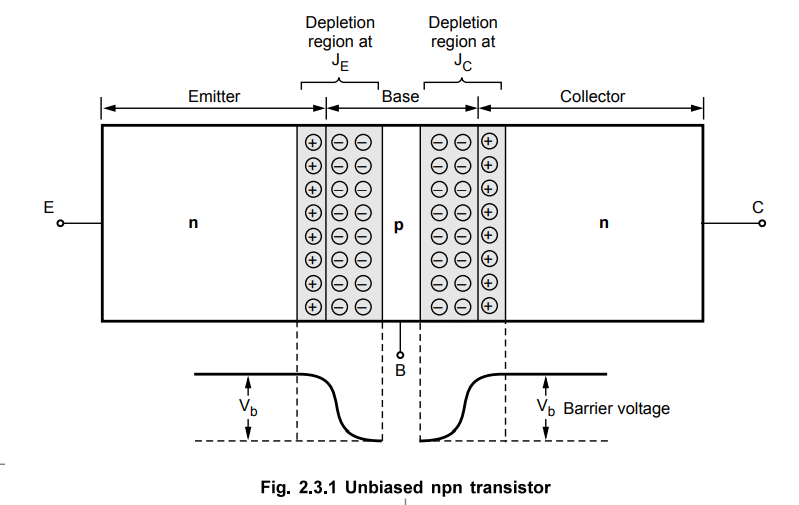
•
During diffusion process, depletion region penetrates more deeply into the
lightly doped side in order to include an equal number of impurity atoms in the
each side of the junction.
•
As shown in the Fig. 2.3.1, depletion region at emitter junction penetrates
less in the heavily doped emitter and extends more in the base region.
•
Similarly, depletion region at collector junction penetrates less in the
heavily doped collector and extends more in the base region.
•
As collector is slightly less doped than the emitter, the depletion layer width
at the collector junction is slightly more than the depletion layer width at
the emitter junction.
•
Barrier voltage is the voltage necessary to cause electrical conduction in a
junction of two dissimilar materials.
•
Like diodes, a barrier voltage exists within transistor.
•
The barrier voltage at each junction is positive on the n-side and negative on
p-side.
•
The barrier voltage across the junction in a silicon transistor is about 0.7
volt and approximately 0.3 volt in a germanium transistor.
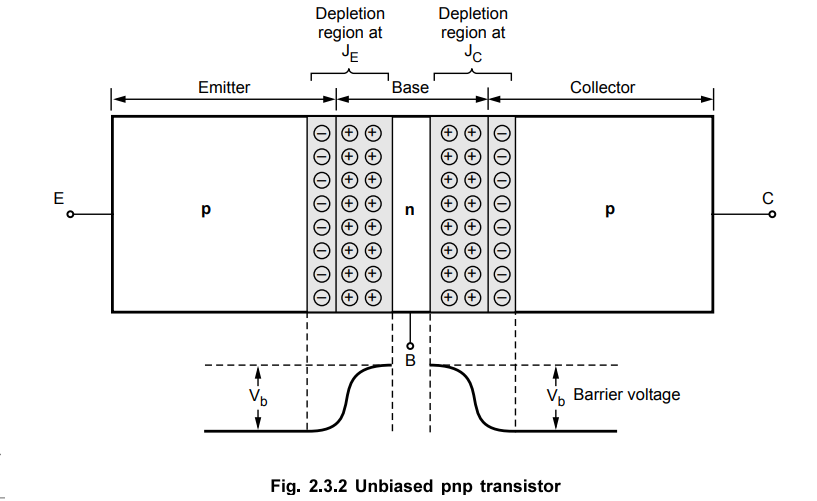
2. Biased Transistor
•
The transistor can be operated in four possible bias combinations depending on
whether forward or reverse bias is applied to each junction. These are listed
in Table 2.3.1.
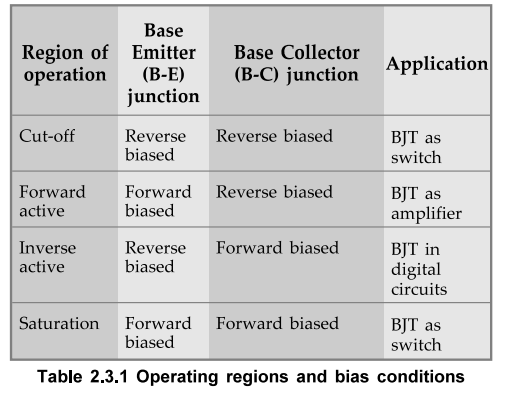
a.
Inverse Active Mode
•
The active mode of transistor is further classified as forward active and
inverse active.
•
In inverse active mode, B-E junction (JBE) is reverse biased and B-C junction
(JBC) is forward bias.
•
In this operating mode, the transistor is operating upside down; that is, the
emitter is acting as the collector and the collector is operating as the
emitter.
•
The Fig. 2.3.3 shows the bias conditions for four modes of operations of an npn
transistor.
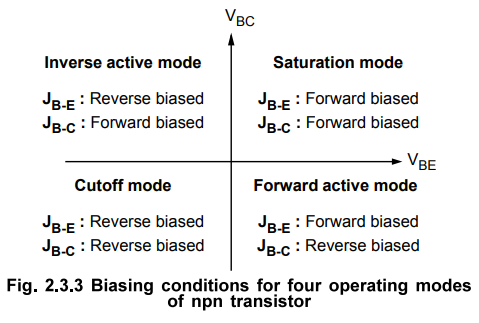
•
To bias the transistor in its active region, the emitter base junction is
forward biased, while the collector-base junction in reverse-biased as shown in
Fig. 2.3.4.

•The
Fig. 2.3.4 shows the circuit connections for active region for both npn and pnp
transistors.
•
The externally applied bias voltages are VEE and VCC, as shown in Fig. 2.3.4,
which bias the transistor in its active region. The operation of the pnp is the
same as for the npn except that the roles of the electrons and holes, the bias
voltage polarities and the current directions are all reversed.
•
Note that in both cases the base-emitter (JE) junction is forward biased and
the collector-base junction (JC) is reversed biased.
3. Operation of npn Transistor
•
The base to emitter junction is forward biased by the d.c. source VEE. Thus,
the depletion region at this junction is reduced. The collector to base
junction is reverse biased, increasing depletion region at collector to base
junction as shown in Fig. 2.3.5.
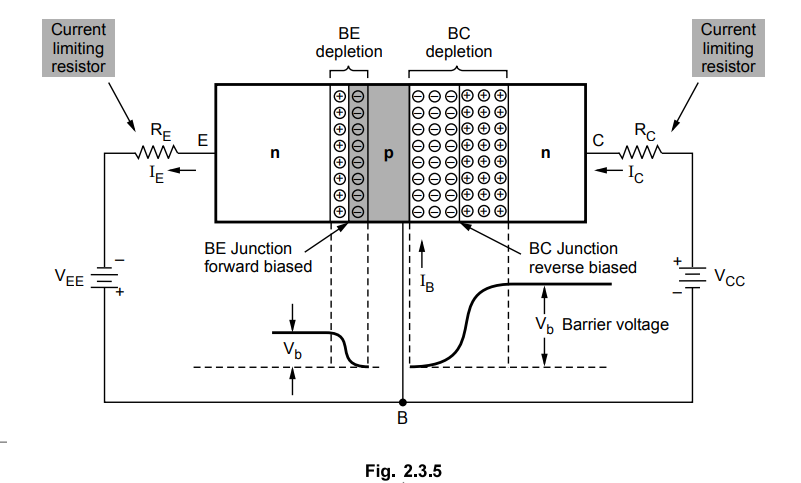
•
The forward biased EB junction causes the electrons in the n-type emitter to
flow towards the base. This constitutes the emitter current IE. As
these electrons flow through the p-type base, they tend to combine with holes
in p-region (base)
•
Due to light doping, very few of the electrons injected into the base from the
emitter recombine with holes to constitute base current, IB and the
remaining large number of electrons cross the base region and move through the
collector region to the positive terminal of the external d.c. source.
•
This constitutes collector current IC. Thus the electron flow
constitutes the dominant current in an npn transistor.
•
Since, the most of the electrons from emitter flow in the collector circuit and
very few combine with holes in the base. Thus, the collector current is larger
than the base current. The relationship between these current is given by
IE
= IC + IB
•
This relationship is also obtained by applying Kirchhoff s current law to the
transistor of Fig. 2.3.4.
•
Since it is a bipolar device, the collector current comprises two components :
majority and minority.
•
The minority current component is called the leakage current and is given the
symbol ICO (IC current with emitter terminal open).
•
The collector current, therefore, is determined in total by
IC = ICmajority + ICO
minority
=
IC(INJ) + ICO
IC(IBJ)
: It is an injected collector current due to majority carriers crossing
the collector base junction.
4. Operation of pnp Transistor
•
The pnp transistor has its bias voltages VEE and VCC
reversed from those in the npn transistor. This is necessary to forward-bias
the emitter-base junction and reverse-bias the collector base junction.
•
The forward biased EB junction causes the holes in the p-type emitter to flow
towards the base. This constitutes the emitter current IE.
•
As these holes flow through the n-type base, they tend to combine with
electrons in n-region (base). As the base is very thin and lightly doped, very
few of the holes injected into the base from the emitter recombine with
electrons to constitute base current, IE
•
The remaining large number of holes cross the depletion region and move through
the collector region to the negative terminal of the external d.c. source. This
constitutes collector current Ic. Thus the hole flow constitutes the dominant
current in an pnp transistor.
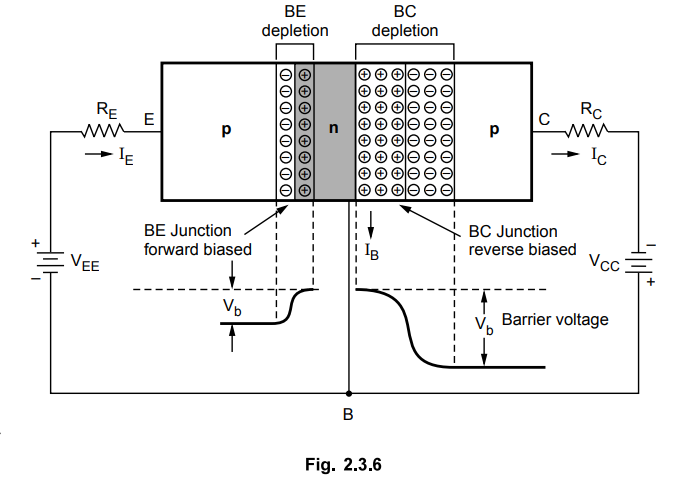
5. npn Transistor
•
The Fig. 2.3.7 shows the terminal voltages and its polarities for an npn
transistor. The voltage between base and emitter is denoted as VBE. For VBE,
base is positive than emitter because for npn transistor, the base is biased
positive with respect to the emitter.
•
The voltage between the collector and the emitter is denoted as VCE and the
voltage between the collector and the base is denoted as VCB. Since collector
is positive with respect to base and emitter the polarities are as shown in the
Fig. 2.3.7.
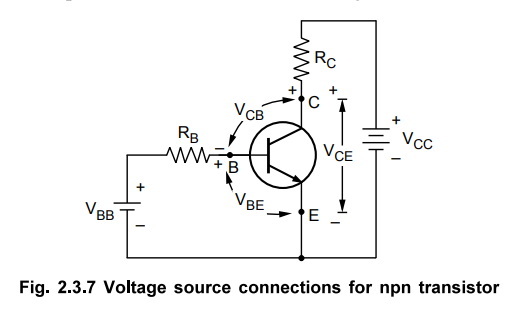
•
The Fig. 2.3.7 shows the npn transistor with voltage source connections. The
voltage sources are connected to the transistor with series resistors. These
resistors are called current limiting resistors.
•
The base supply voltage VBB is connected via resistor R^, and the collector
supply voltage, VCC is connected via resistor RC.
•
The negative terminals of both the supply voltages are connected to emitter
terminal of the transistor.
•
To make CB junction reverse biased, the supply voltage VCC is always much
larger than supply voltage VBB.
pnp
Transistor
•
The Fig. 2.3.8 shows the terminal voltages and its polarities for a pnp
transistor. For a pnp transistor, the base is biased negative with respect to
the emitter, and the collector is made more negative than the base.

•
The Fig. 2.3.8 shows the pnp transistor with voltage source connections. Like
npn transistor voltage sources are connected with series resistors. The source
voltage positive terminals are connected at the emitter with VCC larger than
VBB to keep collector-base junction reverse biased.
Junction
Voltages
•
In different conditions such as active, saturation and cutoff there are
different junction voltages. The junction voltages for a typical npn transistor
at 25 °C are given in the Table 2.3.2.
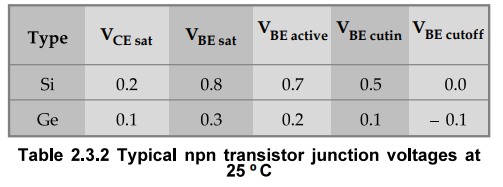
•
The entries in the table are appropriate for an npn transistor. For pnp
transistor the signs of all entries should be reversed.
6. Transistor Currents
•
The directions of conventional currents in an npn transistor are as shown in
Fig. 2.3.9 (a) and those for a pnp are shown in Fig. 2.3.9 (b).

•
It can be noticed that the arrow at the emitter of the transistor's symbol
points in the direction of conventional current.
•
Let us consider pnp transistor. The current flowing into the emitter terminal
is referred to as the emitter current and identified as IE. The currents
flowing out of the collector and base terminals are referred to as collector
current and base current, respectively.
•
The collector current is identified as IC and base current as IB. For both npn
and pnp transistors, IE = IB + IC
•
Since IB is very small, IE and Ic are nearly equal; however, IE > Ic.
Review Questions
1. Explain various voltage components of transistor.
2. Explain the various current components of the transistor.
3. Draw a sketch to show the various current components in a NPN
transistor and deduce the relation between various current components.
4. Sketch the symbols of transistors and mark the current
directions.
5. Give the biasing arrangement for an NPN transistor to operate
in the active region.
AU : ECE ; May-13, Marks 2
6. Sketch and explain the minority carrier electron
concentration across the base region of an npn bipolar transistor biased in the
forward-active mode.
7. State expressions of IC, IE and IB.
8. Draw a block diagram transistor. Identify each depletion and
show the voltages. Briefly explain.
AU : Dec.-l0, Marks 5
9. Explain the working principle of npn transistor.
AU : May-09, Marks 4
10. Clearly show the biasing arrangement of a PNP and NPN transistors
for conduction.
11. Explain with a neat diagram, the working of pnp transistor.
12. Mention the biasing conditions of emitter base junction and
collector base junction in active region and cut-off region.
AU : May-09, Marks 2
13.Explain the construction and operation of NPN transistor with
neat sketch. Also comment on the characteristics of NPN transistor.
AU : Dec.-14, Marks 16
Electron Devices and Circuits: Unit II: (a) Bipolar Junction Transistors (BJT) : Tag: : Bipolar Junction Transistors (BJT) - Principle of Operation of Transistors
Related Topics
Related Subjects
Electron Devices and Circuits
EC3301 3rd Semester EEE Dept | 2021 Regulation | 3rd Semester EEE Dept 2021 Regulation
